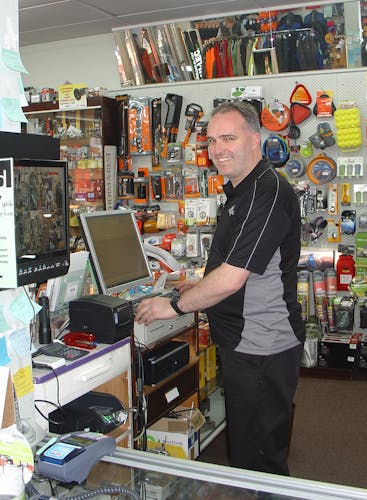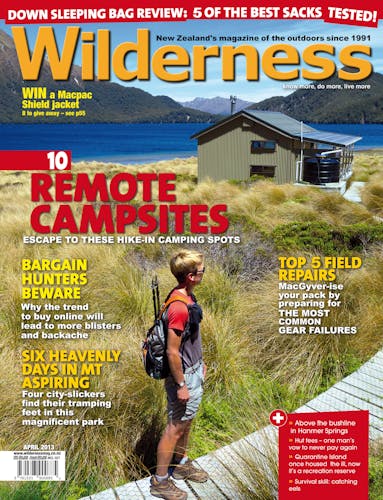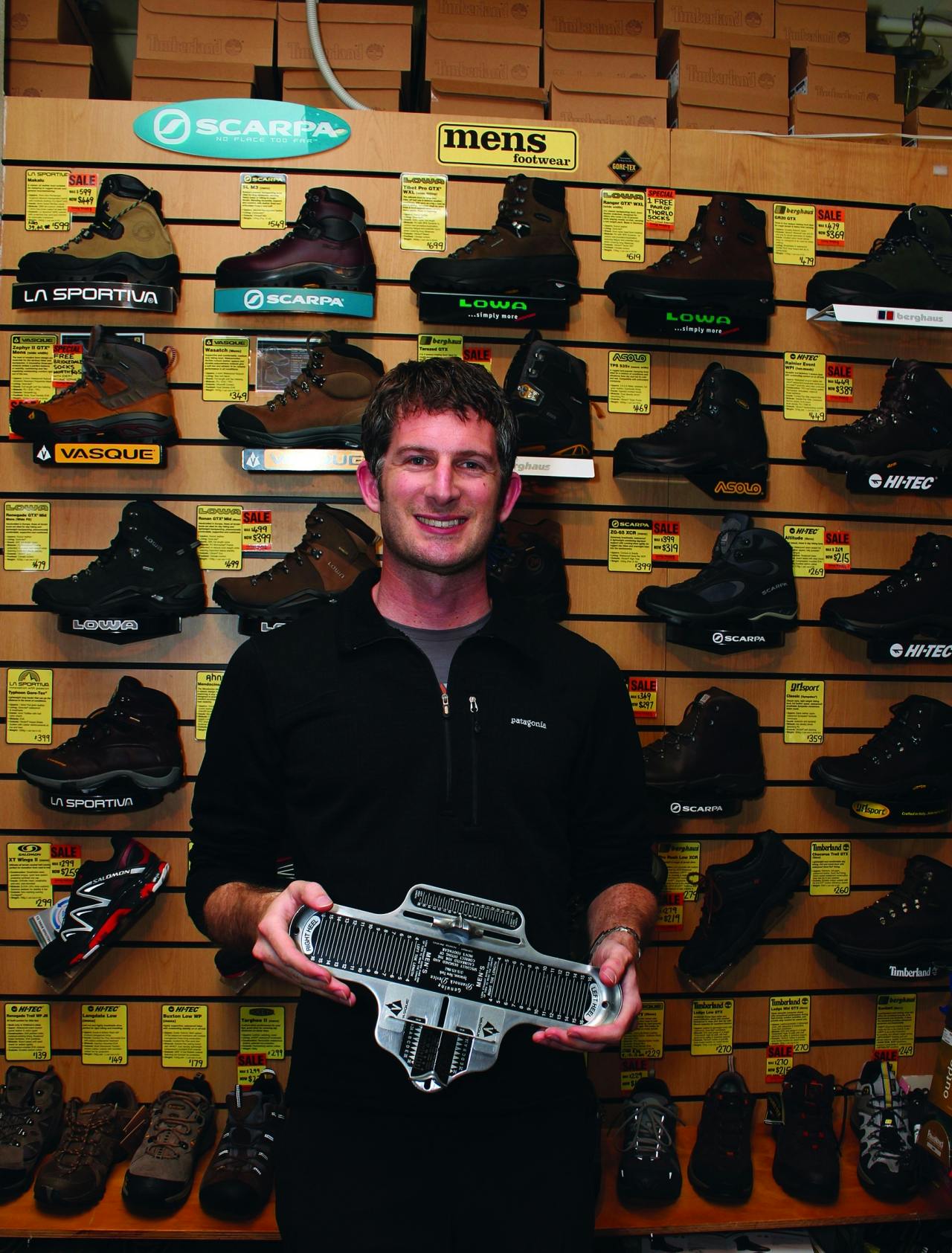The economic downturn has hit independent outdoor retailers hard while consumers have more choice than ever.
If you live in Auckland and are in need of a new pair of boots, chances are those in the know will point you to ‘that little store up the stairs opposite Kathmandu’, on Newmarket’s Broadway.
Living Simply, as that little store is known, has been owned and operated by Mark Sinclair for 25 years. It’s a family business, with Mark’s son Ben now doing much of the day-to-day running of the shop. Over this time, they’ve built up an enviable reputation as the best boot fitters in Auckland. The reason, according to Ben, is simple: low staff turnover. “If we get a new employee they will usually be here for two years. Jobs don’t come up often,” he says. With low turnover, staff are given three months training in the intricacies of gear fitting before being let loose on the shop floor. And nothing is more intricate than fitting a pair of boots. “It’s at least a good hour each boot sale,” says Sinclair. “It’s hard graft.”
During the Sinclair’s 25 years in the outdoor retail game, they’ve faced a lot of challenges to their business. Macpac pulled out of retail to supply its own branded stores. Discount-focussed retailers Kathmandu and Mountain Designs opened right next door and brought with them seemingly never-ending sales. Consumers have changed, too. They’re more price-conscious and aware of bargains available online, will try on a pair of boots and then haggle over the price, pointing to an overseas-based website offering the same boot for less. The result? “It’s very rare that people are buying from us at full retail price,” says Sinclair.
It’s a familiar scene being played out across all retail sectors, but outdoor retail – a niche but hugely competitive category – is doing it particularly tough.

Craig Burke from Southern Adventure says people get advice from him and then head online for cheaper prices. Photo supplied
One distributor of a well-known outdoor brand told Wilderness many of the retailers his company supplies would happily give it up tomorrow. The only thing stopping them, he said, is that they don’t know what they would do.
Craig Burke from Southern Adventure in Invercargill and current president of the Kiwi Outdoors Group of 17 independent retailers was once part of a chain of 30 independent stores under the Scout banner. His store, now rebranded, is the only one left.
He says he doesn’t know how many independent retailers are left in New Zealand but says there are less now than 10 years ago.
Ben Sinclair says he’s not at the stage of closing up shop. “I think we’re so established that, even though it’s getting harder, we’re also getting separated further and further from the chain store, vertical model. We’re getting more and more specialised while they are getting more and more run of the mill generic.”
There’s no doubting the vertically integrated stores like Kathmandu, Macpac and Mountain Designs are squeezing the margins of independent outdoor retailers. Every time a sale is announced, the independents feel the need to follow suit. However, independent retailers Wilderness spoke to said the big ‘chain’ stores are not the main threat to their survival – “Business attracts business,” says Sinclair of the two stores within a few metres of his store front.
Burke says online shops are his biggest threat, even though a Macpac store recently opened just down the street from him.
“Retailers are finding it tough in the outdoor industry because people are coming into the store to try on clothing and footwear and then buying it online,” says Burke. It’s a sign of his frustration that he says: “We think we should start charging for our service because we’re putting our time into fitting people with a pair of boots and then they buy it elsewhere.”
By contrast, the Macpac store down the road has actually increased foot traffic to his store: “What that’s done has brought more people to our area,” he says. “We offer different products to what they do; we have a point of difference.”
The online problem is one Sinclair acknowledges, too: “People do come in and use us as a changing room and then go shopping for the best price. I know it happens, but it’s not at a point where it’s a major concern for us. I think we offer enough service for people to want to commit to buy from us.”
It’s service that both Sinclair and Burke say separates them from their competition – the online and the vertically integrated variety. With price-oriented consumers scouting for bargains, finding a sales assistant who understands their needs can persuade them to fork out more for a brand they wouldn’t have had the opportunity to buy at a vertical store.
Despite the myriad challenges facing the outdoor retail sector, consumers have never had it so good. From the price war being waged between Macpac and Kathmandu to the sheer variety of brands available in stores, consumers are spoilt for choice at every price point. Brand variety hit its peak in the years after Macpac pulled out of supplying independent retail stores in 2008 to focus on stocking its own stores.
“It opened the floodgates for a lot of brands that couldn’t previously enter the country,” says Sinclair. “For the consumer, it’s great – take your pick.” But Macpac’s move did cause upset, possibly even spelling the end for some independent stores who relied on the brand.
“It made our job harder,” says Sinclair. “We had this void, what do we fill it with? There isn’t just one trusted local brand who could supply. You’ve got to choose what’s the best European, Australian or American brands to fill that void. For the first couple of years we were just feeling our way with a few new brands and seeing what worked.”
Sinclair says he now stocks a better range of packs and footwear than many of his bigger competitors. “Although we have a small footprint over the shop, if you looked at our range we’ve probably got 10 times the variety of the huge Kathmandu shop down the road. We’ve got a huge footwear wall, we’ve got a huge pack wall.”
Wayne Martin, CEO of Bivouac Outdoors, says Macpac’s pull-out and the price-cutting practised by vertically integrated stores forced his company to broaden the range of gear his 10 outlets stock, too. “We’ve gone for premium brands from all around the world that we have imported. We try to get staff who are interested in the outdoors and do a good job of selling it.”
Bivouac is mostly supplied by its own distribution arm, Southern Approach, which imports everything from Osprey packs to Go Pro cameras. This allows the company to compete on price, even if it struggles to match the vertical stores’ huge end of season sales. “Because most of our brands are global we have to try and match world pricing,” says Martin. “If there’s an Osprey pack on sale in America, we can’t make it twice the price in New Zealand because people would buy online. We tend to try and get it as close to what the rest of the world is selling it for as we can.”
But for how long will the brand diversity last? Bivouac isn’t the only independent retailer with its own distribution arm. R&R Sport imports many of the brands it sells in order to improve margins and with independent stores in decline, it leaves companies like Beattie Matheson, the New Zealand distributor of Lowa boots, with fewer outlets in which to sell their product. That’s one reason Berghaus, a top European brand also distributed by Beattie Matheson, didn’t take off here. After spending years trying to build the brand and sell it into a diminishing number of retail stores, Beattie Matheson eventually gave up.
“Independent retailers can source the best brands, local or international, for their customers,” says Sascha Langenbach, Beattie Matheson’s sales and business development manager. “But with a decline in independent retailers, independent wholesalers will question the viability of importing brands and selling into a diminishing non-vertical retail base.” It’s not all gloom and doom though, he adds: “I still think there is a fantastic choice. It’s still pretty rich out there. There’s always someone who’s going to say New Zealand is a fantastic outdoor market, there must be an opportunity there.”
If consumer choice does become limited through restricted supply, one option could be for distributors and independent retailers to start their own websites. Bivouac Outdoor has done this, but agreements with brand owners mean the company can’t supply many of its products to markets outside New Zealand. Martin says the online store, therefore, is not about reaching an international market, but about broadening the company’s reach in New Zealand. “We struggle to have stores in small centres because we don’t sell enough,” he says. “I imagine that most of our competitors that have a vertical model probably have twice the margin that we do [so it’s economically viable]. For us, the web is a way to sell into those markets.”
But for distributors like Langenbach selling high-end products like outdoor footwear, using a website to sell directly to consumers is not an attractive option. “We would always want to have a wholesaler-retailer relationship because customers want to feel, touch and try on our premium products.”
And that’s where independents say they have an advantage. While the bigger retailers entice consumers into their stores with bargain prices, independents have focussed on service.
“For independent stores, our strength is our service,” says Burke. Like the Sinclair’s, Burke has staff who have worked for him for 10 years or more which he says gives him an advantage of over big box stores like FCO which he claims have “no knowledgeable staff to help you buy the right thing”.
For distributor’s like Langenbach, the service provided at independent stores is what sets them apart: “It’s the key thing they’ve got going for them, to fit the right product to the exact needs of each customer. Over recent years, too much focus has been on a quick bargain at the cost of discomfort and some consumers have been put-off the outdoors altogether. With so much information online, it is critical retailers constantly up-skill and provide exceptional service in store.”
Living Simply’s Ben Sinclair sums up it best. Without stores like his, he says consumers will lose “any form of true advice about products”. Even worse for the specialist footwear fitter: “There’s probably going to be a lot of poorly fitted footwear going on.”
Next time you need to buy a pair of boots, ask yourself what’s more important: price, or getting the pair that not only fits your feet, but your needs. Your answer will determine if you step out your front door, or stay at home and ask Google.








